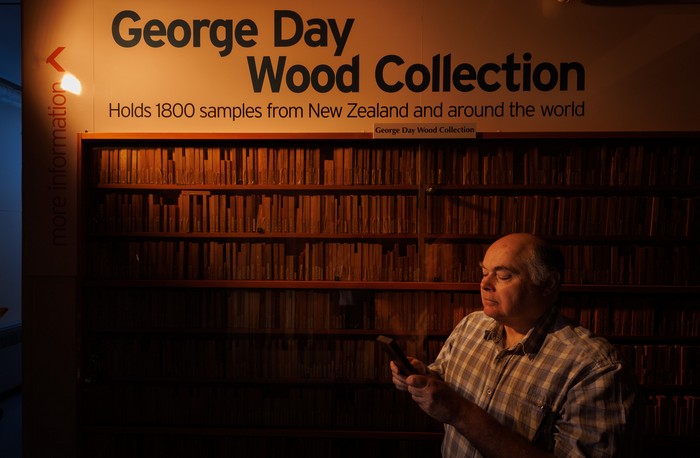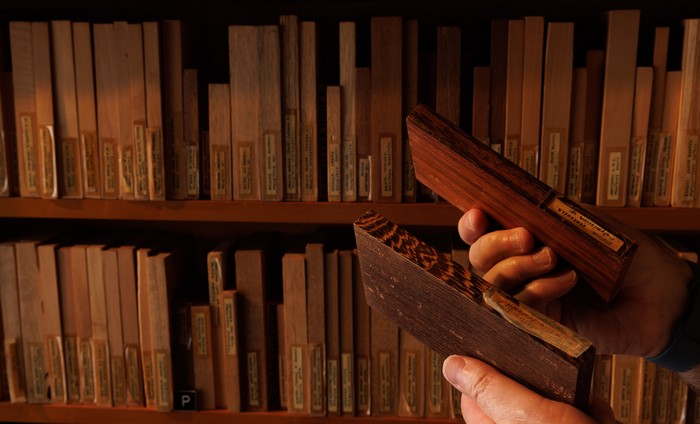A good day to be a tree
21 March 2023
Today (Tuesday 21 March) is a big day for our trees as the world comes together to celebrate World Wood Day and International Day of Forests.
A world of wood
Since its inaugural celebration in 2013 in Tanzania, World Wood Day has been widely celebrated with people coming together to recognise the importance of wood and wood use in our daily life, and to promote a harmonious coexistence between people and nature.
Here at Scion, we care for an extensive Xylarium – a collection of wood samples consisting of thousands of species from all over the world. The Xylarium is an invaluable resource for our scientists, researchers, and students studying wood anatomy, ecology, and evolution. It’s also a fascinating record of the diversity of the world's trees and their importance in human culture and history.
The George Day wood collection was donated to the then Forest Research Institute (then part of the New Zealand Forest Service) by the Vanderwee family in 1979.
George Day (2 June 1903 - 6 March 1978) was a Yorkshireman who came to New Zealand in the 1920s. During his life he was a builder, but whenever he had spare time, he went tramping through the Waitakere Ranges examining the variety of trees and eventually joined the International Wood Collectors Society in the United States. His wood collection lives on in Scion’s Xylarium, with each piece lovingly handcrafted and polished.
Day's collection now forms part of the Scion wood collection containing approximately 1,800 wood samples from New Zealand and around the world. The collection includes some rare and endangered species such as Alerce from Chile, as well as some examples of swamp wood from buried forests at various locations in New Zealand.

Custodian of the Xylarium and George Day wood collection is senior scientist Lloyd Donaldson. He says the samples continue to fascinate visitors to Scion for their historic value.
“Online databases are used to identify wood now but there was a long period of time in Scion’s history when samples were physically inspected and shared between researchers within New Zealand and internationally. With some samples from trees that are now endangered or even extinct, the collection serves as a reminder of a different time and the world’s rich diversity.”
Scion is joining the world in its celebrations with Scion’s emeritus scientist, Rowland Burdon, speaking at this year’s online World Wood Day Symposium (21 - 22 March). He’ll be speaking on the topic of “Updating the concept of juvenile wood, in a new conceptual framework.”
Wood in Cultural Heritage
This year’s theme – Wood in Cultural Heritage - highlights the critical role of wood in our history, traditions, and heritage.
Wood has been widely used for various structural and non-structural purposes and their distinct uses have characterised regions, societies, and ethnicities around the world. Predominantly used in buildings and other structures, wooden cultural heritage is also prominent in decorative, artefact, ritual, and spiritual applications where an inherent emotional link between humanity and wood of various forms has developed over thousands of years.
For example, the rare and endangered Alerce (Fitzroya cupressoides) from Chile found in Scion’s collection, was widely used during the colonial period for roof shingles, furniture, and ship masts. Today, because of serious exploitation, its range has been reduced to less than 15% of its original area, located mostly in the remote and difficult to access high cordillera of the Andes.
Chile has banned logging of the species since 1976, and it is listed on Appendix I of the Convention on International Trade in Endangered Species of Wild Fauna and Flora (CITES), the most restrictive listing which bans international trade of the species in most cases.
Last year, an Alerce tree measuring four meters across was estimated by scientists to be more than 5,000 years old, potentially earning the title of the world’s oldest tree.
Scion is extremely fortunate to have this special wood as part of its collection, as getting a sample into the country now would be an impossible feat without a special permit.

Healthy forests equal healthy people
From purifying the water, cleaning the air, capturing carbon to fight climate change, providing food and life-saving medicines, and improving our well-being, forests are clearly linked to many aspects of our lives.
This year’s International Day of Forests – themed forests and health – calls for giving, not just taking, by promoting the undeniable fact that healthy forests translate to healthy people.
In November, the fifth International Congress on Planted Forests is being held in Nairobi, Kenya, to review and discuss challenges and opportunities in harnessing the potential of planted forests to meet growing human needs, restore forest ecosystems, and mitigate climate change. Tim Payn, Heidi Dungey, Grace Villamor, and Peter Clinton are involved with the organisation of the Congress with colleagues from IEFC, FAO, ICRAF-CIFOR, IUFRO, and WWF-NGP.
Tim Payn and Serajis Salekin will be presenting a global paper on the outlook of planted forests and forest products (a revisiting of the 2015 paper “Changes in planted forests and future global implications” that has been collaborated on with the U.S.A, China, Brazil, UK, France, and Italy. The paper gives a global perspective of trends in planted forests and looks at some of the risks, e.g., climate change and markets. The call for abstracts closes 30 April 2023.
However, Tim explains that the congress will be important for re-connecting with international networks in person – new and established and a great opportunity for Scion Early Career Researchers to build networks.
“The significance for Scion and Aotearoa is that we can draw on the experience and expertise of our international colleagues, allowing us to apply these learnings to New Zealand forests so that we’re not inventing everything ourselves from scratch”.
“This is the first time the congress is being held in Africa and one focus will be on silvo-pastoral systems which is highly relevant to New Zealand at the moment.
“Forests sustainable management and use of their resources are key to combating climate change, and to contributing to the prosperity and well-being of current and future generations.”
